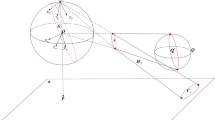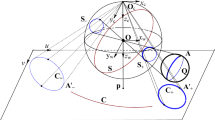Abstract
In this study, we present a calibration technique that is valid for all single-viewpoint catadioptric cameras. We are able to represent the projection of 3D points on a catadioptric image linearly with a 6×10 projection matrix, which uses lifted coordinates for image and 3D points. This projection matrix can be computed from 3D–2D correspondences (minimum 20 points distributed in three different planes). We show how to decompose it to obtain intrinsic and extrinsic parameters. Moreover, we use this parameter estimation followed by a non-linear optimization to calibrate various types of cameras. Our results are based on the sphere camera model which considers that every central catadioptric system can be modeled using two projections, one from 3D points to a unitary sphere and then a perspective projection from the sphere to the image plane. We test our method both with simulations and real images, and we analyze the results performing a 3D reconstruction from two omnidirectional images.
Similar content being viewed by others
References
Abdel-Aziz, Y., & Karara, H. (1971). Direct linear transformation from comparator coordinates into object space coordinates in close-range photogrammetry. In Symposium on close-range photogrammetry (pp. 1–18).
Baker, S., & Nayar, S. K. (1999). A theory of single-viewpoint catadioptric image formation. International Journal of Computer Vision, 35, 175–196.
Barreto, J. (2006). A unifying geometric representation for central projection systems. Computer Vision and Image Understanding, 103, 208–217.
Barreto, J. P., & Araújo, H. (2005). Geometric properties of central catadioptric line images and their application in calibration. IEEE Transactions on Pattern Analysis and Machine Intelligence, 27, 1327–1333.
Barreto, J., & Daniilidis, K. (2006). Epipolar geometry of central projection systems using Veronese maps. In IEEE computer society conference on computer vision and pattern recognition, 2006, (Vol. 1, pp. 1258–1265).
Bastanlar, Y., Puig, L., Sturm, P., Guerrero, J., & Barreto, J. (2008). Dlt-like calibration of central catadioptric cameras. In Proceedings of the eight workshop on omnidirectional vision, 2008.
Buchanan, T. (1988). The twisted cubic and camera calibration. Computer Vision, Graphics, and Image Processing, 42, 130–132.
Cauchois, C., Brassart, E., Drocourt, C., & Vasseur, P. (1999). Calibration of the omnidirectional vision sensor: Syclop. In Proceedings IEEE international conference on robotics and automation, 1999 (Vol. 2, pp. 1287–1292).
Chahl, J., & Srinivasan, M. (2000). A complete panoramic vision system, incorporating imaging, ranging, and three dimensional navigation. In Proceedings IEEE workshop on omnidirectional vision, 2000 (pp. 104–111).
Derrien, S., & Konolige, K. (2000). Approximating a single viewpoint in panoramic imaging devices. In Proceedings IEEE workshop on omnidirectional vision, 2000 (pp. 85–90).
Faugeras, O. (1993). Artificial Intelligence. Three-dimensional computer vision. Cambridge: The MIT Press.
Geyer, C., & Daniilidis, K. (2000). A unifying theory for central panoramic systems and practical applications. In Proceedings of the 6th European conference on computer vision, Part II, London, UK (pp. 445–461). Berlin: Springer.
Geyer, C., & Daniilidis, K. (2001). Structure and motion from uncalibrated catadioptric views. In Proceedings of the 2001 IEEE computer society conference on computer vision and pattern recognition, 2001, CVPR 2001 (Vol. 1, pp. 279–286).
Geyer, C., & Daniilidis, K. (2002a). Properties of the catadioptric fundamental matrix. In Proceedings of the 7th European conference on computer vision (pp. 140–154).
Geyer, C., & Daniilidis, K. (2002b). Paracatadioptric camera calibration. IEEE Transactions on Pattern Analysis and Machine Intelligence, 24, 687–695.
Hartley, R. I., & Zisserman, A. (2004). Multiple view geometry in computer vision (2nd edn). Cambridge: Cambridge University Press. ISBN:0521540518.
Heikkila, J., & Silven, O. (1997). A four-step camera calibration procedure with implicit image correction. In IEEE computer society conference on computer vision and pattern recognition (pp. 1106–1112).
Horn, R., & Johnson, C. (1985). Matrix analysis. Cambridge: Cambridge University Press.
Horn, R., & Johnson, C. (1991). Topics in matrix analysis (2nd ed.) Cambridge: Cambridge University Press.
Kang, S. B. (2000). Catadioptric self-calibration. In IEEE conference on computer vision and pattern recognition (Vol. 1, pp. 201–207).
Kannala, J., & Brandt, S. (2004). A generic camera calibration method for fish-eye lenses. In Proceedings of the 17th international conference on pattern recognition, 2004, ICPR 2004 (Vol. 1, pp. 10–13).
Lhuillier, M. (2007). Toward flexible 3d modeling using a catadioptric camera. In IEEE conference on computer vision and pattern recognition, 2007, CVPR’07 (pp. 1–8).
Mei, C., & Rives, P. (2007). Single view point omnidirectional camera calibration from planar grids. In IEEE international conference on robotics and automation (pp. 3945–3950).
Nagahara, H., Yagi, Y., & Yachida, M. (2003). Wide field of view head mounted display for tele-presence with an omnidirectional image sensor. In Conference on computer vision and pattern recognition workshop, 2003, CVPRW’03 (Vol. 7, pp. 86–87).
Orghidan, R., Salvi, J., & Mouaddib, E. M. (2003). Calibration of a structured light-based stereo catadioptric sensor. In Conference on computer vision and pattern recognition workshop, 2003, CVPRW’03 (Vol. 7, pp. 70–70).
Scaramuzza, D., Martinelli, A., & Siegwart, R. (2006). A toolbox for easily calibrating omnidirectional cameras. In IEEE/RSJ international conference on intelligent robots and systems, 2006 (pp. 5695–5701).
Scotti, G., Marcenaro, L., Coelho, C., Selvaggi, F., & Regazzoni, C. (2005). Dual camera intelligent sensor for high definition 360 degrees surveillance. IEEE Proceedings on Vision, Image and Signal Processing, 152, 250–257.
Sturm, P. (2002). Mixing catadioptric and perspective cameras. In Proceedings third workshop on omnidirectional vision (pp. 37–44).
Sturm, P., & Barreto, J. (2008). General imaging geometry for central catadioptric cameras. In Proceedings of the 10th European conference on computer vision (Vol. 4, pp. 609–622). Berlin: Springer.
Svoboda, T., & Pajdla, T. (2002). Epipolar geometry for central catadioptric cameras. International Journal of Computer Vision, 49, 23–37.
Swaminathan, R., Grossberg, M., & Nayar, S. (2001). Non single-viewpoint catadioptric cameras (Technical report). Department of Computer Science, Columbia University.
Tardif, J. P., Sturm, P., & Roy, S. (2006). Self-calibration of a general radially symmetric distortion model. In Lecture Notes in Computer Science: Vol. 4. Proceedings of the 9th European conference on computer vision (pp. 186–199). Berlin: Springer.
Toepfer, C., & Ehlgen, T. (2007). A unifying omnidirectional camera model and its applications. In Proceedings of the 11th international conference on computer vision, ICCV 2007 (pp. 1–5).
Author information
Authors and Affiliations
Corresponding author
Rights and permissions
About this article
Cite this article
Puig, L., Bastanlar, Y., Sturm, P. et al. Calibration of Central Catadioptric Cameras Using a DLT-Like Approach. Int J Comput Vis 93, 101–114 (2011). https://doi.org/10.1007/s11263-010-0411-1
Received:
Accepted:
Published:
Issue Date:
DOI: https://doi.org/10.1007/s11263-010-0411-1




